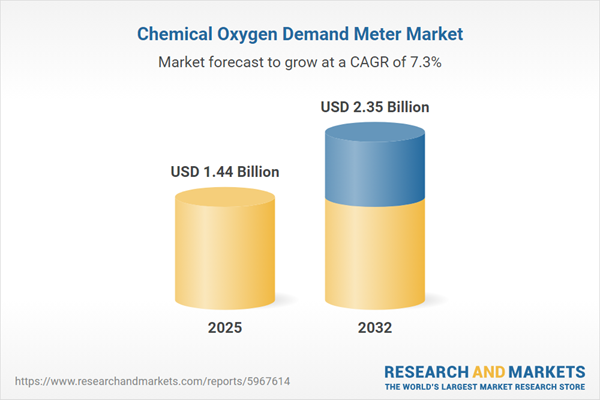Speak directly to the analyst to clarify any post sales queries you may have.
As regulatory expectations intensify worldwide, the chemical oxygen demand meter market is becoming critical for organizations striving to safeguard compliance, optimize operations, and advance sustainability in water quality management. Senior decision-makers must prioritize proven technologies that provide reliable data, operational transparency, and measurable outcomes in environmental performance.
Chemical Oxygen Demand Meter Market Snapshot
The chemical oxygen demand meter market is demonstrating steady expansion, driven by stringent environmental monitoring and tightening regulatory mandates. Currently valued at USD 1.34 billion in 2024, the sector is projected to reach USD 1.44 billion by 2025 and USD 2.35 billion by 2032, supported by a compound annual growth rate of 7.25%. Adoption of sophisticated water diagnostics technology is rising as organizations rely on real-time data and detailed reporting to ensure compliance, showcase sustainability achievements, and promote operational best practices across industrial and municipal water management settings.
Chemical Oxygen Demand Meter Market Scope & Segmentation
- Product Types: Benchtop meters provide laboratory-grade accuracy for complex analysis, while online monitoring systems enable continuous, in-process surveillance. Portable units add flexibility for field diagnostics and adaptable site conditions.
- Technology: Closed reflux models assure precise readings through photometric and titrimetric analysis, while open reflux units—featuring infrared and ultraviolet detection—accommodate both laboratory and on-site use. Systems with colorimetric and rapid digestion features serve varied compliance priorities.
- End Users: Industrial wastewater facilities, municipal utilities, contract testing laboratories, and specialized service providers leverage these systems to enhance process control and regulatory demonstration.
- Industry Verticals: Industries ranging from chemical manufacturing and oil and gas to food and beverage processing and pharmaceuticals depend on these meters for product quality oversight and resource management.
- Applications: Meters deliver essential support for water quality monitoring, laboratory process assurance, air emissions checks, and ongoing operational optimization. Both real-time and legacy data enable trend identification and prompt regulatory interventions.
- Sales Channels: Direct engagement with manufacturers, regional distributor partnerships, and digital procurement platforms support robust supply chain continuity and quick access to solutions.
- Regional Coverage: Asia-Pacific is seeing rapid uptake as compliance landscapes evolve. Europe and the Americas maintain steady market adoption, while the Middle East and Africa play an active role in standard-setting.
- Notable Players: Danaher Corporation, Thermo Fisher Scientific, Shimadzu Corporation, HORIBA, Mettler-Toledo, Xylem Inc., Yokogawa Electric, Siemens AG, Agilent Technologies, and ABB Ltd meet a broad array of operational requirements across regions.
Chemical Oxygen Demand Meter Market: Key Strategic Takeaways
- Deployment of IoT-enabled and cloud-integrated meters allows centralized oversight, enabling executive teams to efficiently supervise compliance and manage audits across sites.
- Reagent-efficient measurement technologies are helping organizations align environmental initiatives with cost-saving goals, facilitating more attainable sustainability milestones.
- Modular and scalable product designs support dynamic compliance demands and changing production profiles, allowing organizations flexibility without investing in unnecessary upgrades.
- Comprehensive system adaptability permits accurate results under diverse regulatory constraints, safeguarding measurement reliability.
- Partnerships among manufacturers and service specialists assure access to advanced features and tailored sector solutions as regulatory and market needs evolve.
Tariff Impact: Navigating U.S. Trade Policy Shifts
Recent adjustments in U.S. trade policy and tariffs are prompting organizations to reevaluate sourcing approaches for chemical oxygen demand meters and related components. Strategies such as strengthening domestic supplier networks, nearshoring, and proactive risk assessment are being adopted to sustain operational resilience and maintain compliance despite shifting trade dynamics.
Methodology & Data Sources
The report’s analysis is grounded in a comprehensive review of product specifications, recent regulatory documents, and insights from experienced professionals in the environmental and chemical industries. Supplier perspectives further validate findings, equipping leaders with practical, credible market intelligence.
Why This Report Matters
- Helps procurement and supply chain teams benchmark trusted partners, anticipate regional fluctuations, and manage risk for uninterrupted supply.
- Provides senior executives with essential analysis of technology evolution, compliance shifts, and sourcing tactics for faster, more effective decision-making.
- Supports leadership in choosing vendors that align with core compliance and sustainability requirements through comprehensive market evaluation.
Conclusion
Leading organizations investing in advanced chemical oxygen demand meter solutions are well positioned to overcome compliance hurdles, drive sustainability progress, and reinforce stakeholder confidence in regulated industries.
Additional Product Information:
- Purchase of this report includes 1 year online access with quarterly updates.
- This report can be updated on request. Please contact our Customer Experience team using the Ask a Question widget on our website.
Table of Contents
3. Executive Summary
4. Market Overview
7. Cumulative Impact of Artificial Intelligence 2025
Companies Mentioned
The companies profiled in this Chemical Oxygen Demand Meter market report include:- Danaher Corporation
- Thermo Fisher Scientific, Inc.
- Shimadzu Corporation
- HORIBA, Ltd.
- Mettler-Toledo International Inc.
- Xylem Inc.
- Yokogawa Electric Corporation
- Siemens AG
- Agilent Technologies, Inc.
- ABB Ltd.
Table Information
| Report Attribute | Details |
|---|---|
| No. of Pages | 181 |
| Published | November 2025 |
| Forecast Period | 2025 - 2032 |
| Estimated Market Value ( USD | $ 1.44 Billion |
| Forecasted Market Value ( USD | $ 2.35 Billion |
| Compound Annual Growth Rate | 7.2% |
| Regions Covered | Global |
| No. of Companies Mentioned | 11 |









